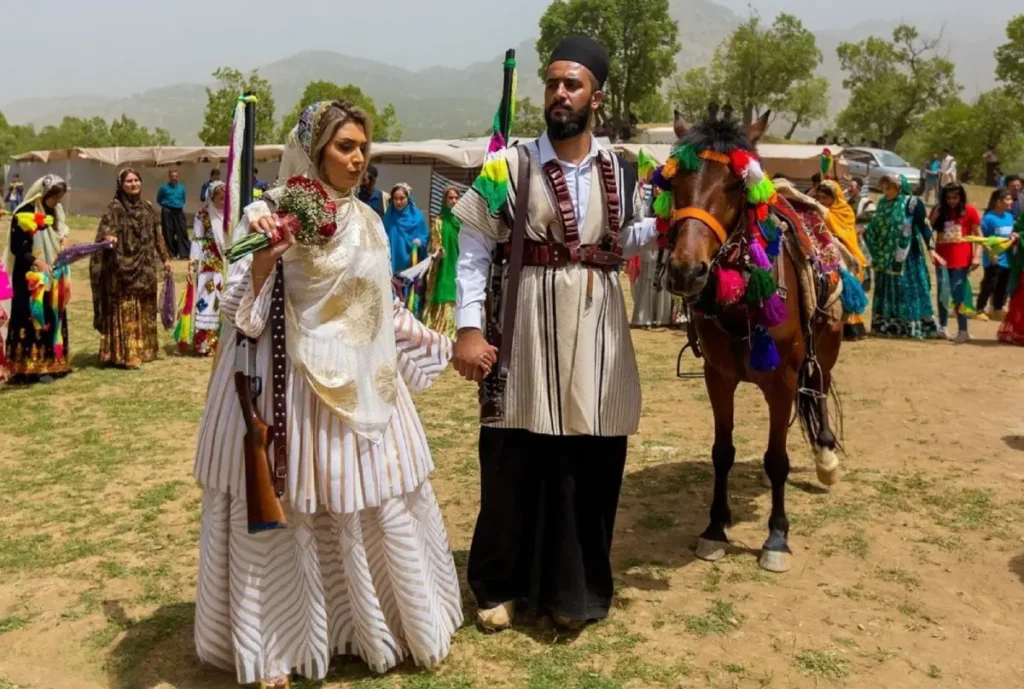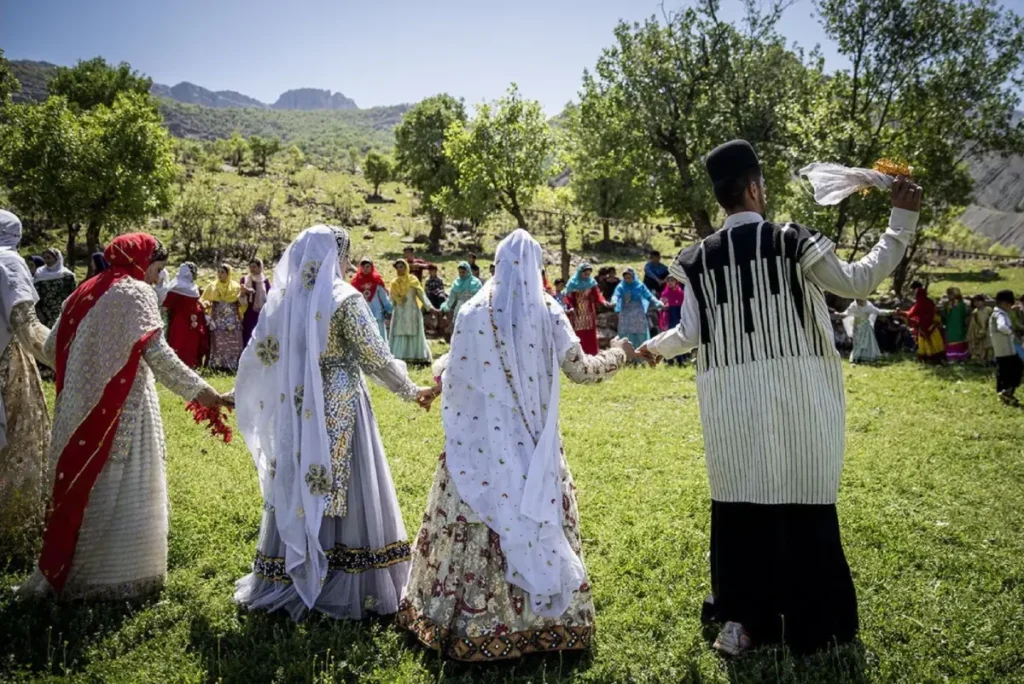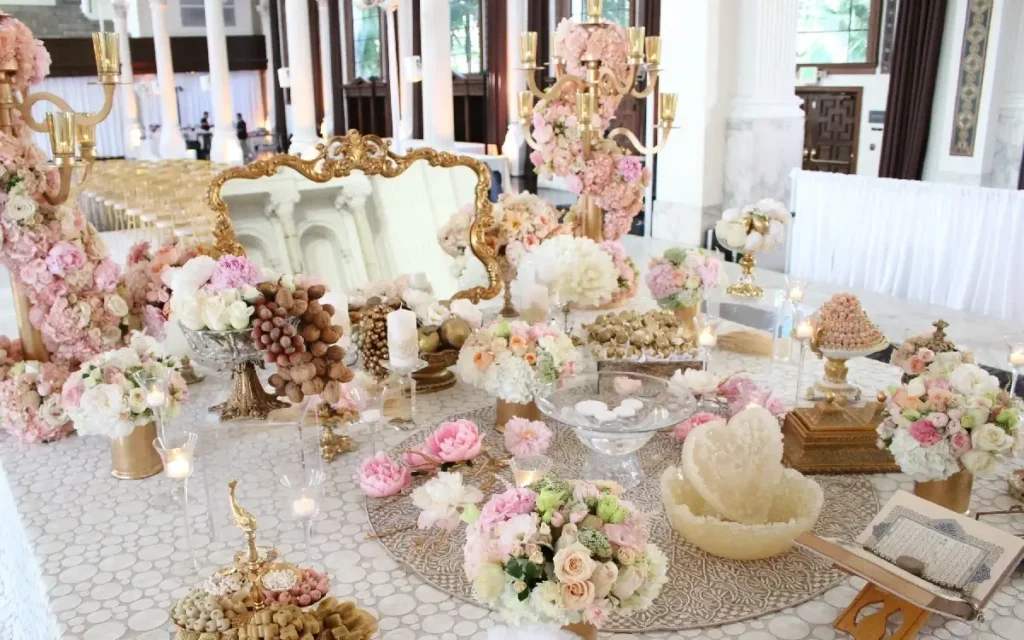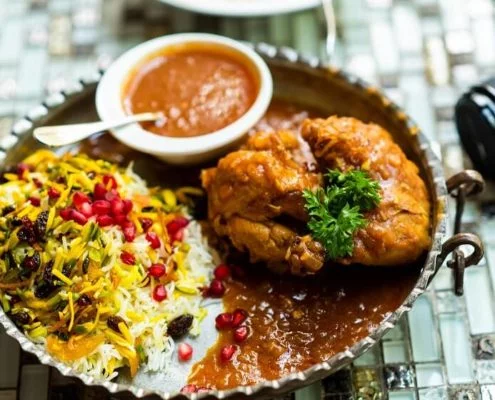Iran is a country rich in cultural diversity and ancient traditions, and wedding ceremonies are one of the highlights of this rich culture. Each region of Iran has its own unique wedding traditions, which not only symbolize love and commitment but also express the ethnic and historical identity of the people. From special dances and music to the attire of the bride and groom, every detail tells a story. Understanding these captivating ceremonies can inspire younger generations and offer an opportunity to preserve and transmit these traditions. In this guide, we will explore the wedding customs of different cultures in Iran and provide practical tips for hosting these ceremonies.
Kurdish Weddings: Music, Dance, and Colorful Clothing
Kurdish weddings are among the most beautiful ceremonies in Iran, filled with vibrant colors, energy, and traditional music. These ceremonies often last for several days, with each day featuring its own unique customs. Music and local dances play a major role in Kurdish weddings. The “daf” (a type of drum) and “tanbur” (a stringed instrument) are popular instruments, and their sounds accompany group dances such as the “Halperke.” One significant part of the Kurdish wedding is the “Henna Night,” held the evening before the wedding. On this night, the bride’s hands and feet are decorated with henna while family and friends gather to celebrate with music and dance. This tradition symbolizes joy and the bride’s preparation for a new life.
The bride’s attire in Kurdish weddings is often traditional, featuring intricate designs and bright colors, while the groom wears local clothing with charming patterns. Guests also dress in regional outfits, adding to the visual appeal of the ceremony. Local dishes, such as “Dizi” and other regional specialties, hold a special place in the celebration. Kurdish weddings are a display of unity, joy, and respect for the authentic culture of the region, creating unforgettable memories for all participants.

Northern Iranian Weddings: Gilaki and Mazani Traditions
Weddings in Northern Iran, especially in Gilan and Mazandaran, are a blend of tradition, nature, and freshness. These ceremonies reflect the culture and local customs, creating a unique and attractive celebration. From clothing to food and rituals, everything reflects the authenticity of the northern people. One important custom in northern Iranian weddings is the “Jahaz Bran” (bride’s dowry delivery). On a special day, the bride’s family brings her dowry to the groom’s house, a ceremony full of excitement. The family members decorate and arrange the items in the groom’s house, making the event visually appealing.
Northern Iranian weddings are typically accompanied by local music and dances, such as those from the Gilaki and Mazani cultures. Instruments like the “ney” (flute) and local string instruments create a pleasant atmosphere, encouraging guests to dance. The bride and groom wear traditional outfits from Gilan and Mazandaran, adding a unique beauty to the ceremony. Northern dishes, including “Baqala Ghatogh” and “Mirza Ghasemi,” are served, inviting guests to taste unforgettable flavors. These weddings are a combination of ancient traditions and modernity, offering a memorable experience for the bride, groom, and their families.
Nomadic Weddings: A Celebration of Nature and Tradition
Nomadic weddings in Iran are celebrated in the heart of nature, emphasizing ancient customs without the complexities of urban life. These ceremonies create a warm and intimate atmosphere, highlighting unity and collective culture. Every step of a nomadic wedding reflects the traditions of the nomadic lifestyle. One key event in a nomadic wedding is the “Shirini Khoran” (sweet offering), which marks the official start of the wedding. During this ceremony, both families exchange sweets as a symbol of mutual agreement and respect, strengthening the bond between the two families.
The bride and groom wear traditional, handmade clothing, which tells a story of the nomadic culture. Bright colors and authentic designs distinguish these outfits from those worn in other weddings. Local dances, accompanied by drums and singing, are an inseparable part of these celebrations. The guests gather in an open, natural space, dancing and celebrating the joyful moments. The food is another highlight, made with fresh, organic ingredients, offering delicious and memorable tastes. Nomadic weddings are a testament to the deep connection between humans and nature, providing a unique and valuable experience.
Bakhtiari Weddings: Courage and Glory in Ceremony
Bakhtiari weddings are among the most memorable in Iran, reflecting the rich culture and unique traditions of the Bakhtiari people. These ceremonies not only celebrate joy and festivity but also express the social and familial values of the Bakhtiari tribe. Every stage of the ceremony is accompanied by specific rituals that honor tradition. One of the most notable aspects of a Bakhtiari wedding is the involvement of tribal elders, who play an essential role in overseeing the ceremony. From the initial proposal to the wedding night, the elders ensure that the traditions are followed, showing the importance of family unity in Bakhtiari culture.
The bride and groom wear traditional, embroidered clothing that reflects the glory and heritage of the Bakhtiari people. The bride’s dress is often rich in detail, with vibrant colors and beautiful handwork, while the groom wears his distinctive Bakhtiari attire. The “Chub Bazi” dance, performed by the men of the tribe, is an exciting highlight of the wedding, symbolizing courage, strength, and unity. Traditional Bakhtiari music, played with instruments like the “kamancheh” and “serna,” creates a lively atmosphere. At the end of the ceremony, guests are treated to local dishes, such as Bakhtiari kebab, creating a memorable feast. Bakhtiari weddings are full of energy, respect for tradition, and social solidarity, leaving lasting memories for everyone involved.
Southern Iranian Weddings: Warm Southern Sounds on Wedding Night
Weddings in Southern Iran, particularly in Khuzestan, Hormozgan, and Bushehr, stand out for their diversity of traditions and the lively music and dance that fill the air. These weddings combine Arabic, Bandar, and Iranian cultures, creating a warm and energetic atmosphere. A key feature of Southern weddings is the live music and group dances. Instruments like the “neyanban” (bagpipes), “damam” (drums), and “oud” (a type of lute) add a unique flair to the ceremony. Local dances, such as “Liwa” and “Yazleh,” are performed by groups of guests, adding excitement to the celebration.
The bride typically wears beautiful, bright clothing with designs influenced by Arabic and Bandar traditions, while the groom dons local attire. These traditional outfits add a special and distinctive touch to the ceremony. Southern Iranian wedding food, including dishes like “Qaliyeh Mahi” (fish stew) and “Mahshi Shekam Poreh” (stuffed fish), are key highlights of the celebration. These weddings not only offer joy and festivity but also bridge generations and cultures, creating a lively and unforgettable experience for the bride, groom, and guests.

Zoroastrian Weddings: A Ceremony Full of Spirituality and Light
Zoroastrian weddings are among the most beautiful and spiritual in Iran. Rooted in ancient Iranian rituals, these ceremonies focus on purity, light, and love. One of the most important moments of the wedding is the “Afireh” (fire lighting) ceremony. Here, the bride and groom sit next to a sacred fire and recite the “Ashmo Vohu” prayer, which sanctifies their union. The fire symbolizes light and purity, playing a significant spiritual role throughout the ceremony.
The bride typically wears a white dress, symbolizing purity, while the groom wears traditional attire with symbols representing Zoroastrian culture. The ceremony is accompanied by specific prayers and traditional Zoroastrian music. The families prepare local delicacies to welcome guests and strengthen familial bonds. This simple and pure ceremony not only marks the marriage but also represents faith and spiritual connection. A Zoroastrian wedding offers a peaceful, spiritual experience for the couple and their guests.
Wedding Gifts: From Quran to Gold and Jewelry
Wedding gifts in Iranian culture are an expression of respect and love for the bride and groom. These gifts often vary depending on local customs and the family’s financial situation, but their importance is universal across the country. One common gift is the Quran, given as a symbol of blessing and guidance to the couple. In some regions, a key is given as a symbol of happiness and the opening of doors to success in the couple’s life.
Gold and jewelry are also popular gifts, representing financial security and support for the couple’s new life together. In traditional ceremonies, families sometimes collectively provide gifts to demonstrate their support and unity. These wedding gifts are part of the emotional connection between the families and show the support for the couple’s future. This beautiful tradition remains a vital part of Iranian wedding ceremonies, creating lasting memories.
Bridal and Groom Attire: Diversity of Clothing in Different Cultures
In Iran, bridal and groom attire is incredibly diverse, with each region designing special clothing based on local customs and traditions. These garments not only enhance the beauty of the ceremony but also reflect the cultural and historical identity of the region. In northern Iran, brides often wear traditional dresses with bright colors and beautiful hand-embroidered details. In the southern regions, bridal clothing is influenced by Arab and Bandar cultures, often featuring shiny fabrics and intricate patterns.
Grooms’ attire also follows local customs. In nomadic areas, groom clothing is made of sturdy, simple materials, reflecting a close connection to nature. In urban areas, a formal suit is a modern choice. While traditional bridal and groom attire reflects local culture, adding modern elements to the clothing design can give the ceremony a fresh and unique look. Choosing outfits that harmonize with the local culture gives the wedding a special and unforgettable touch.
Combining Tradition and Modernity in Iranian Weddings
Iranian weddings, with their long history, reflect ancient traditions and cultural values. However, in today’s modern world, blending these traditions with contemporary elements can help create a unique and unforgettable experience. One of the most important tips is to maintain essential customs such as Henna Night, Patakhti, and the marriage contract ceremony. These rituals are core to the Iranian wedding identity and should be carefully preserved alongside modern practices.
Choosing modern decorations inspired by traditional elements can significantly enhance the ceremony. Using traditional fabrics for decorations or designing bridal and groom attire with a mix of modern and traditional elements helps achieve this. Additionally, traditional music and dances, combined with modern technologies like lighting and professional photography, can create a captivating atmosphere. This combination of tradition and modernity ensures that the wedding remains connected to its cultural roots while offering a fresh and unique experience.

Special Traditions: From Henna Night to Post-Wedding Celebrations
In every country, weddings have specific customs and stages. The Iranian wedding process is a beautiful journey that unfolds over several important steps. Each stage has its own significance, and understanding them will help you appreciate the cultural traditions of this ceremony when you visit Iran.
1. The Engagement (Khastegari)
In the past, Iranian families selected a suitable bride for their son based on personal preferences and family views. This process involved the groom’s family visiting the bride’s home, where the bride would serve tea to the guests and answer their questions. Over time, this tradition evolved, and nowadays, couples often meet before the engagement ceremony. If they agree to marry, they inform their families and proceed to organize the engagement ceremony. It’s an exciting time when both families formally meet, and everyone begins planning for the wedding.
2. Setting the Mahr (Mahrieh)
The mahr (also called mahrieh) is an important part of Iranian weddings. It is a sum of money or valuable assets agreed upon by both families. The mahr is the wife’s right and is meant to be something the husband can afford. Traditionally, it holds symbolic importance, though in modern times it can sometimes be used as leverage in marriage disputes. The agreed-upon mahr amount is a formal commitment in Iranian culture and must be carefully considered during wedding planning.
3. The Formal Engagement Ceremony (Baleh Boron)
Once the couple has agreed to marry, the formal engagement ceremony, or Baleh Boron, takes place with the presence of close family members. During this ceremony, the families discuss the details of the wedding, including the dowry, wedding expenses, and the date for the actual wedding. An important tradition in this stage is the groom’s family offering gifts like rings or fabric as a gesture of goodwill and commitment. This is a joyful occasion where both families come together to confirm the union.
4. The Marriage Contract (Aqd)
After the formal engagement, the next stage is the marriage contract ceremony. This can be held in a variety of locations, such as the bride’s home, a wedding hall, or a legal office. Typically, the bride’s family is responsible for covering the costs of this event. During the ceremony, a religious officiant reads the marriage vows, and at this moment, the couple becomes legally and religiously married. Following the contract, the couple can begin to live together and spend time learning more about each other before the wedding celebration.
5. Signing the Marriage Certificate (Aqd Nameh)
In Iranian weddings, an important and official step is the signing of the marriage certificate (Aqd Nameh) in front of a notary. This ceremony is more formal and includes the presence of at least two legal witnesses. It is a vital process in which both the bride and groom sign the official document to legally validate their marriage.
6. The Wedding Spread (Sofreh Aqd)
The Sofreh Aqd (wedding spread) is an essential part of the Iranian wedding ceremony. During the event, the bride and groom sit by a table set with symbolic items like honey, herbs, bread, cheese, fruits, and sugar. The table is often decorated with candles and mirrors, creating a beautiful and traditional atmosphere. A special tradition called “Qand Sabidan” involves breaking sugar over the bride and groom’s heads as a symbol of sweetness in their future life together.
7. The Bride’s Homecoming (Pagoshayi)
One of the most enduring traditions in Iranian weddings is the bride’s homecoming ceremony, or Pāgushāyi. After the wedding, the couple visits each of their families’ homes. This visit is a warm celebration where relatives invite the bride and groom over and offer them gifts. It serves to strengthen social ties and make the couple feel welcomed into both sides of the family.
8. Preparing the Bridal Dowry (Jahizieh)
In the past, the bridal dowry was chosen together by the bride and groom with the assistance of their families. Today, the couple typically handles the shopping for the dowry on their own. The dowry usually includes items such as furniture, kitchenware, a wedding dress, a groom’s suit, and cosmetics. In the days leading up to the wedding, close relatives help set up the dowry at the bride and groom’s homes, and this process is called “Jahiz Baran.”
9. The Henna Ceremony (Henna Bandan)
The night before the wedding, the bride celebrates the Henna Ceremony, or Henna Bandan, at her home. This is a festive, pre-wedding tradition where female relatives take the bride to the bathhouse for grooming and preparation. Afterward, the bride returns home and begins the celebrations, which include music, dancing, and sharing sweets. At the end of the ceremony, the bride’s hands are decorated with henna, and guests are invited to participate if they wish.
10. The Wedding Celebration (Jashn-e Arusi)
The wedding day is filled with joy and celebration. Following the ceremony, guests head to the bride’s family’s house, where the groom’s family is welcomed. A significant part of this ceremony is when the bride’s father places her hand in the groom’s, symbolizing the formal handover. The families exchange gifts and blessings. Afterward, the couple is escorted to the groom’s house, where his family hosts a grand meal to celebrate the union. This is a time for everyone to rejoice, share stories, and begin to celebrate the couple’s new life together.
11. The Post-Wedding Gathering (Patakhti)
The Pātakhti ceremony typically takes place the day after the wedding. The bride, dressed in beautiful attire, sits on a chair while guests dance, sing, and offer gifts. This ceremony is a final opportunity for family and friends to gather and celebrate the couple’s new life and union. It’s a joyful event where well-wishers show their support for the newlyweds.

12. The Honeymoon (Mah-e-Asal)
After the wedding celebrations and Pātakhti, the couple embarks on their honeymoon, or Mah-e-Asal. This tradition allows the newlyweds to spend time together and bond in a peaceful setting, whether they choose to travel inside Iran or abroad. The honeymoon marks a time for relaxation, personal connection, and the beginning of married life.
These stages are a part of the rich cultural heritage of Iranian weddings, and each step is filled with meaning and significance. As an international tourist in Iran, you can expect to witness many beautiful and memorable customs that have been passed down through generations, giving you a deeper understanding of the country’s rich traditions. Whether you are invited to a wedding or simply observing, these ceremonies offer a unique experience into Iranian culture.
Romantic Tours for Couples in Iran
Your wedding journey doesn’t have to end with the ceremony—why not explore Iran together on a memorable trip? At Visit Our Iran, we offer specially designed tours for couples, allowing you to experience Iran’s rich culture, breathtaking landscapes, and romantic destinations. Whether you’re looking for adventure, relaxation, or a mix of both, our tours provide the perfect balance.
Personalized Honeymoon Packages
Not only can you explore Iran’s stunning cities, but we also offer exclusive hotel deals tailored for couples. From luxury resorts to charming boutique hotels, you’ll find the perfect place to celebrate your new life together. Our full-service tours ensure a seamless and enjoyable experience, letting you focus on making memories.
Romantic Experiences to Enjoy
- Spiritual Honeymoon in Mashhad – If you’re interested in a religious experience, you can visit the Imam Reza Shrine in Mashhad, where a special section is designated for honeymooners. Many couples take part in traditional ceremonies here before continuing their journey.
- Relaxing Beach Getaways in Kish – After an exciting wedding, unwind on the beautiful island of Kish. Enjoy pristine beaches, luxury resorts, and romantic sunset cruises on the Persian Gulf.
- Historical and Cultural Discoveries – Walk hand in hand through the ancient ruins of Persepolis, discover the stunning architecture of Isfahan, or explore the vibrant bazaars of Tehran.
- Cooking Classes Together – Experience Iran’s culinary traditions with hands-on cooking classes in different cities. Learn to make local dishes, cook alongside expert chefs, and enjoy your homemade meal together.
Iran offers a unique blend of history, culture, and natural beauty, making it a wonderful destination for couples. Whether you prefer city life, nature, or a mix of both, our tours are designed to make your honeymoon unforgettable.

